基于高静水压力处理颗粒的异体骨板制造新工艺
IF 3.5
4区 材料科学
Q2 MATERIALS SCIENCE, CHARACTERIZATION & TESTING
引用次数: 0
摘要
目前常用的处理同种异体骨移植物的方法,如伽马辐照,其缺点是改变移植物的力学性能。作为一种替代方法,高静水压力(HHP)可以在不影响骨基质及其力学行为的情况下有效地使细胞失活。为了解决临床应用问题,将hhp处理过的骨颗粒制备成骨板,可用于颌骨区域的增强。为了达到足够的机械强度,对两种不同的胶粘剂进行了测试。通过三点弯曲试验进行力学表征。此外,我们还进行了细胞毒性分析和间充质干细胞定殖实验,以研究骨板的骨传导性。虽然由纤维蛋白胶组成的板具有更好的生物相容性,但用乐泰®408制备的板具有更好的机械性能,可以纳入模型应用。与无骨板培养的细胞相比,无论是否有粘接剂,骨板都能诱导成骨分化。尽管结合这两种特性的粘合剂在以后的临床应用中是必要的,但目前的研究表明,用hhp处理过的颗粒生产同种异体骨板是可能的,这满足了下颌增强的基本要求。本文章由计算机程序翻译,如有差异,请以英文原文为准。
A new manufacturing process for allogeneic bone plates based on high hydrostatic pressure–treated granules for jaw augmentation
Abstract Currently used methods for processing allogeneic bone grafts like gamma irradiation are connected with downside of altering the mechanical properties of the graft. As an alternative, high hydrostatic pressure (HHP) leads to an effective devitalization of cells without influencing the bone matrix and its mechanical behavior. To address the clinical application, bone plates were prepared out of HHP-treated bone granules, which are conceivable for augmentations in the jaw region. In order to achieve sufficient mechanical strength, two different adhesives were tested. Mechanical characterization by three-point bending tests was performed. Furthermore, analysis regarding cytotoxicity as well as colonization experiments with mesenchymal stem cells were performed to investigate osteoconductive properties of the bone plates. While plates composed of fibrin glue showed better biocompatibility, plates prepared with Loctite® 408 showed better mechanical properties and could be incorporated in a model application. Regardless of the adhesive, bone plates induced osteogenic differentiation compared to cells cultured without bone plates. Although an adhesive combining both properties would be necessary for later clinical application, the study at hand demonstrates the possibility of producing allogeneic bone plates from HHP-treated granules, which meet the basic requirements for jaw augmentation.
求助全文
通过发布文献求助,成功后即可免费获取论文全文。
去求助
来源期刊

Materials Testing
工程技术-材料科学:表征与测试
CiteScore
4.20
自引率
36.00%
发文量
165
审稿时长
4-8 weeks
期刊介绍:
Materials Testing is a SCI-listed English language journal dealing with all aspects of material and component testing with a special focus on transfer between laboratory research into industrial application. The journal provides first-hand information on non-destructive, destructive, optical, physical and chemical test procedures. It contains exclusive articles which are peer-reviewed applying respectively high international quality criterions.
 求助内容:
求助内容: 应助结果提醒方式:
应助结果提醒方式:


